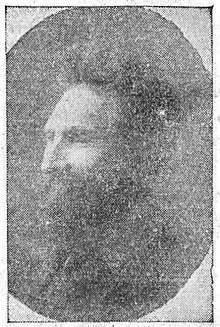Ernesto Bark
Ernst Moritz Heinrich Bark Schultz (1858–1922), known as Ernesto Bark, was a Livonian writer, journalist and political activist based in Spain. He took part in the Bohemian scene in Madrid.
| Ernesto Bark | |
|---|---|
 | |
| Born | 23 March 1858 Kaava, Laiuse, Russian Empire |
| Died | 24 October 1922 Madrid, Spain |
| Occupation | Opinion writer, journalist, political activist, language teacher |
| Signature | |
Biography
Born on 23 March 1858 in Kaava, Laiuse,[1] in the vicinity of Dorpart, then part of the Russian Empire. Regarding his self-identification, aside from presenting himself as a Livonian, he declared to have three nationalities: "the German one from an ethnographic standpoint, the Russian one from a political standpoint (and unfortunately) and the Spanish one because of affection and love".[2] In any case, he also contextually self-identified as a Baltic German in his writings.[3] He even declared to be "Polish" on some occasions.[3] Pío Baroja dubbed him as a "Latvian revolutionary".[4] He took studies in Riga, Leipzig, Munich and Berlin.[5]
Involved in Baltic nationalist propaganda,[6] he founded the clandestine newspaper Der Baltische Föderalist in Switzerland in 1883, whose success reportedly led to a deportation to Siberia.[7] He settled in Spain circa 1884 (after a previous brief stay in 1882).[8] Prior to his settlement in Madrid, he lived for a time in Alicante.[9] He worked as writer for Germinal,[4] as well as correspondent for Köln Zeitung and National Zeitung.[5] He also earned a living in Spain as teacher of foreign languages. During his time in Madrid, he supported along his friend Isidoro López Lapuya Jewish immigrants coming from Russia.[10] A noted polemicist vis-à-vis his political activity, espousing republican-socialist ideas, Bark held feuds with Pablo Iglesias Posse and Juan Montseny Carret (Federico Urales).[5] A close acquaintance of Alejandro Sawa,[11] the character Basilio Soulinake in Ramón María del Valle-Inclán's Luces de bohemia is based on Bark.[12]
He became a member of the Radical Party circa 1910.[5] Several tentative death dates, ranging from 1914 to 1924 have been reported in sources.[13] He actually died in his home in Madrid located at Calle de Ayala 57 on 24 October 1922,[14] as it is reported in several obituaries published in newspapers such as La Libertad[15] or El Liberal.[16] Instead of the Civil Cemetery, he was buried on the next day in the Almudena Cemetery following the Catholic rite professed by his wife Matilde Cabello,[17] with whom he had six children.[5]
References
- Citations
- Thion Soriano-Mollá 1998a, p. 15; González Martel 2003, p. 704.
- Bark, Ernesto (1888). España y el extranjero. Madrid: Impr. La Publicidad. p. VII.; cf. Thion Soriano-Mollá 1998a, p. 15
- Thion Soriano-Mollá 1998a, p. 15.
- Philips 1985, p. 349.
- Thion Soriano-Mollá 2005, pp. 131–141.
- Thion Soriano-Mollá 1998a, p. 23.
- Thion Soriano-Mollá 2012, pp. 905–917.
- Thion Soriano-Mollá 1998a, p. 23; Thion Soriano-Mollá 2005, pp. 131–141
- Rubio Jiménez 2006, p. 148.
- Thion Soriano-Mollá 1998a, pp. 304–305.
- Irigoyen 2009.
- Rubio Jiménez 2006, p. 147.
- Thion Soriano-Mollá 1998a, pp. 53–54.
- González Martel 2003, pp. 704–705.
- Muerte de Ernesto Bark. La Libertad. IV. Madrid. 25 October 1922. ISSN 9968-4942.
- Ernesto Bark. El Liberal. XLIV. 25 October 1922. ISSN 2174-6648.
- González Martel 2003, p. 707.
- Bibliography
- Irigoyen, Ramón (4 April 2009). "En el centenario de Sawa". El País.
- González Martel, Juan M. (2003). "Ernst von Bark Schultz, un publicista radical "rusohispano", ante el "Basilio Soulinake" de "Luces de bohemia" de Ramón de Valle Inclán". Actas del Congreso Internacional "La Lengua, la Academia, lo Popular, los Clásicos, los Contemporáneos. II. Alicante: Universidad de Alicante. pp. 693–708.
- Philips, Allen W. (1985). "Algo más sobre la bohemia madrileña: testigos y testimonios" (PDF). Anales de Literatura Española. Alicante: Universidad de Alicante (4): 327–362. doi:10.14198/ALEUA.1985.4.15. ISSN 0212-5889.
- Rubio Jiménez, Jesús (2006). Valle-Inclán, caricaturista moderno: nueva lectura de "Luces de bohemia". Madrid: Editorial Fundamentos. ISBN 84-245-1100-X.
- Thion Soriano-Mollá, Dolores (1998a). Ernesto Bark. Un propagandista de la modernidad (1858-1924). Alicante: Instituto de Cultura Juan Gil-Albert. ISBN 84-7784-313-9.
- — (1998b). "Ernesto Bark, un romántico revolucionario". In Díaz Larios, Luis F.; Miralles, Enrique (eds.). Del Romanticismo al Realismo: Actas del I Coloquio de la Sociedad de Literatura Española del Siglo XIX (Barcelona, 24–26 de octubre de 1996). Universitat de Barcelona.
- — (2005). "Ernesto Bark, un visionario de Europa / Dolores Thion Soriano-Mollá". Revista Interlitteraia (10): 131–141.
- — (2012). "Los Vencidos d'Ernest Bark von Schultz. Roman politique d'un vainqueur méconnu". Bulletin hispanique (114–2): 905–917. doi:10.4000/bulletinhispanique.2243. ISSN 1775-3821.